Sep 30, 2020 | Anxiety, Fire
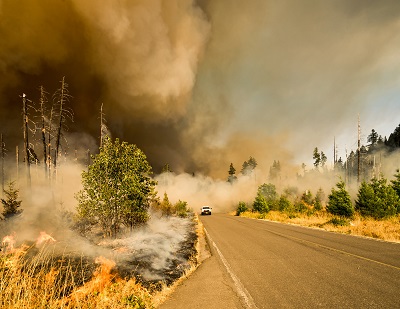 A muffled crack of thunder, followed by a flash of light that lit up the bedroom wall. Then another, louder CRACK! I had been lying in bed awake since 1AM, for three hours, my husband next to me, deep asleep. But now the wind was pushing violently against our windows, and I woke him up. I did not want to be experiencing this alone. We pulled the slider open and stepped out onto our bedroom deck, surveying western Sonoma County. Every thirty seconds another jagged bolt of lightning flashed somewhere on the horizon. In forty years of living in California we’d ever seen anything like this. There were the thunderstorms when we visited my mother-in-law in Florida. But here we were missing a crucial counterbalance to the lightning. Rain.
A muffled crack of thunder, followed by a flash of light that lit up the bedroom wall. Then another, louder CRACK! I had been lying in bed awake since 1AM, for three hours, my husband next to me, deep asleep. But now the wind was pushing violently against our windows, and I woke him up. I did not want to be experiencing this alone. We pulled the slider open and stepped out onto our bedroom deck, surveying western Sonoma County. Every thirty seconds another jagged bolt of lightning flashed somewhere on the horizon. In forty years of living in California we’d ever seen anything like this. There were the thunderstorms when we visited my mother-in-law in Florida. But here we were missing a crucial counterbalance to the lightning. Rain.
When the previous night news reports had warned about the possibility of dry lightning it hadn’t seem possible. But now it was more real than anyone would have predicted. Could every strike of lightning start a fire? In our dry, heavily forested landscape what would that mean? “This feels like the end of the world,” my husband said, “Let’s pack the car and get out of here while we can.”
Flashback
Almost three years earlier, in October 2017, we were awakened at 1 AM by a friend calling us to tell us we needed to get out of our home, now! The smell of smoke filled the room. The electricity was out. We frantically pulled on our clothes and within five minutes we were in our car, inching our way through the smoke towards safety. An hour later our home and everything we owned was gone.
Much of the same emotions I felt at that time were here again, telling me to flee. But I knew something was different this time. Now, in our rebuilt home, standing in virtually the same spot in our bedroom, I recognized danger. But unlike the threat of three years before, this threat was not imminent. “Yes, let’s pack the car,” I said, “But I’m not going anywhere just yet.”
Safety and Security Shattered
Over the next 72 hours, the lightning strikes started hundreds of fires in California, Oregon and Washington, some that are still burning. As I write this newsletter, a new fire is raging only five miles from my home. The smoke from these fires is fouling the air, affecting millions of people hundreds of miles away. This at the same time we are suffering the worst pandemic in a hundred years, an economy threatening to slip into a depression, and the worst political and social unrest in decades.
What Should We Do?
As a CBT therapist working with clients who think their world is falling apart, and as a human being who has similar thoughts myself, I know that our natural instinct is to take action. Whether it is fighting or taking flight, or even freezing in place, our first reaction to the threat of loss is usually emotional reaction. We’re hard-wired this way. This leads to behaviors, like my husband wanting to jump in the car and get away. The problem with taking action when we are upset, is that it is unlikely to be wise action. The storm that morning was passing over us, casting bolts of lightning in every direction. Some of them could start fires, but which ones we’d have no way of knowing. Imagine my husband and I driving around Northern California, each time there was a strike of lightning ahead, turning the car around and driving a different direction. Imagine hundreds of thousands of other cars doing the same thing.
With an imminent threat, like a smoke-filled bedroom, our emotions are well equipped to guide us. But most of the threats we face today, though real, are not imminent, and thus, require wise action. And to unlock our own innate wisdom, we need to be able to tolerate the fight-flight emotions telling us to Do something now!
The therapy I provide for my anxious clients is simply teaching them to relax and lean into fear. Unless it becomes clear that action is called for, just being, not doing, is how we free ourselves from the trap of chronic fight-flight reactions to our anxiety.
Emotion & Meditation
In a perfect storm of uncertainty that we are all living in today it is of some comfort to me to know that spiritual masters agree. Pema Chodron, a Buddhist nun, has written extensively on how to find peace amid crisis. She says we must stay with our broken heart, our fear, our anger and outrage, that only by sticking with uncertainty do we learn to relax in the middle of chaos. This is the essence of mindfulness meditation—to place our attention on the thoughts, feelings, and emotions that are disturbing us in the moment, without attachment, judgment, storytelling, or problem-solving.
Many of us are familiar with the exercise of watching our thoughts without attachment, but it is often more difficult for us to do the same with our feelings. To curb our urges to resist and/or control our negative emotions, we must learn to experience the sensation of emotions in a grounded way, dropping our awareness out of our heads and into our bodies. The simplest path is to use our breath to open, surrender, allowing our muscles to soften, making space for our emotions to metabolize. Only when we can relax amidst the chaos of our emotions, can we conceive what is wise action.
Wise Action
The morning of the lightning storm, we packed our car with emergency supplies, water, tent, sleeping bags, and food. But we didn’t drive off looking for a safe place. We went for a silent hike in a wooded area that had burned the year before. In the distance we could see the storm continuing, but we could also see new growth coming back and many of the old oaks had survived. Nature has a way of healing itself. We too have a natural ability to heal ourselves. And I believe, that collectively, we will be able to heal from the crisis that we face—from fires, from the pandemic, from the political polarization and social injustice, to whatever we face in the future. The first step is for each of us to move from a fight-flight reaction to wise action.
Meditation for Emotion
By opening up to painful emotions, we are learning to relax into discomfort itself. This meditation will help you to be here for yourself, no matter what you are feeling. You can listen to this meditation by clicking here.
This article first appeared on the website of the Anxiety and Depression Association of America.
Aug 3, 2020 | Anxiety, Coronavirus, Uncertainty

Should I return to the office…Get my haircut…Send my kids back to school?
My client Tom had been working from home since the pandemic hit in March, but now his boss had set a date for returning to the office, in only three weeks. Tom felt anxious about prolonged exposure to his co-workers, as his partner had an underlying health condition. He was stuck on what to do. Should he negotiate to continue working from home, or comply with his boss’s request to go back to the office? One choice could put his job at risk, the other his partner’s health.
When there is no downside to a decision, we can feel confident about our choice. But many of the decisions we face today have pros and cons, complex situations like school options for our children, vacation and wedding trips, and making doctor and dentist appointments. Our limbic system is designed to warn us away from negative consequences with negative emotions like anxiety and fear. The only agenda of this monkey mind is safety.
Trying to please the monkey keeps us stuck in a loop of worry and indecision. Before we can make complex decisions with confidence, we need to understand that our purpose is not to eliminate choices that have cons, but to accept the uncertainty that accompanies them.
4-Step Decision Making Protocol
To help my clients move from of obsessive worry to confident decision-making, I’ve developed this 4-step decision making protocol.
Step 1. In two separate columns, write down the pros and cons for one of your choices. My client did this for returning to the office.

Step 2. Assign a numerical importance to each pro and con, on a scale of: 3=Very Important, 2=Important, 1= Somewhat Important. Don’t overlook this step; not all reasons are equal. Tom had more pros than cons, but putting a numerical value on each helped him weigh the importance of each.

Step 3. Total up each column.
Pros 4, Cons 6. For Tom, clearly the cons of returning to the office outweighed the pros.
Step 4. Make a final decision.
Tom decided he would negotiate with his boss to continue to work from home. This triggered anxiety about displeasing his boss and appearing demanding, but the exercise he’d done had convinced him he’d chosen as wisely as was possible. Rather than retreating from his decision, Tom chose to accept the cons that came with negotiating with his boss.
Accept Uncertainty = Confidence
The confidence that Tom sought could only be gained by standing up for his choice, owning it, despite the uncertainty of the outcome. Only when we accept the risk inherent in every choice, can we grow from the decisions we make. This is how to make the “right” decision and how to gain true confidence in ourselves.
Download a printable Pros and Cons Worksheet here!
Jul 1, 2020 | Anxiety, Uncertainty
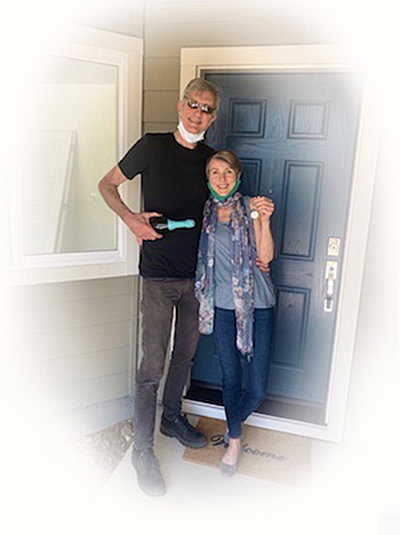
This week, after two and a half years of waiting, my husband and I were given the keys to our rebuilt condo that burned to the ground in the Tubbs fire. It’s beautiful, spacious, full of light, better than before, and being a real “homebody”, I was bursting with joy. Until Friday afternoon, that is, when I checked my e-mail.
Our insurance agent announced that his company was dropping our fire and earthquake insurance! My happiness vanished in an instant, and was immediately replaced by anxiety. I’d heard about other insurance companies refusing coverage in our area; if our company wouldn’t insure us, who would? What if there were an earthquake or another fire when we weren’t insured? Woo, woo, woo! My monkey mind was going wild. And my beautiful new home felt cold and dark.
My husband seemed to be taking the news in stride, which annoyed me. I wanted so badly to fix the problem immediately. What is wrong with him? Lying in bed, I wondered whether I’d be able to sleep that night. I needed expert help to deal with this. So, I got out of bed and had a little therapy session with myself.
Step 1: First, I identified the monkey mindset that was activated: Unless you are certain you are safe from loss, you cannot rest. My thinking this way meant that my peace of mind depended on the decision of a big insurance company, something I couldn’t control. I wanted to be able to feel at home even if I was uncertain about the future of my insurance coverage. The expansive mindset that I wanted was, I can accept what is beyond my direct control.
Step 2: While I had come up with a better way to conceptualize my situation, I still felt a powerful urge to do something. But everything being beyond my direct control, the only action I could take was to ask for help from someone who had some control. I decided to shop for another broker and call the state insurance commission first thing on Monday. That meant a whole weekend of waiting to act, but that was the best plan I could think of, and I’d have to curb my sense of urgency until then.
Step 3: Now I had a new mind-set and an action plan, but predictably, when I got back in bed my anxiety returned. My monkey mind was reminding me that a disaster could strike again, like it had in my past, and if I could not get insurance coverage, I’d be devastated. True enough, thank you, monkey! Then I reminded myself it was normal to feel anxious in my situation, so I didn’t need to resist it. To help keep my mind from returning to the mental story of impending disaster without insurance, I focused my attention on my body, breathing into the discomfort with compassion. And eventually I fell asleep.
The next morning, I woke up to a beautiful, spacious, new home with sunlight streaming in the windows. Nothing external had changed, I still didn’t know whether we’d be able to insure our new home. But uncertain as the future was, I felt grateful for what I had right now, in that moment.
In a world of uncertainty where loss is always threatening, it’s so easy to lose our awareness of the essential miracle of being alive in the present moment. While we want to be grateful for that miracle, when we are hijacked by the monkey mind, we take it for granted. Whatever potential loss is preoccupying us right now—health, social connection, family, job or finances—the three steps to gratitude are always available. 1) Unconditionally accept the uncertainty that is part of life, 2) curb the urge to act compulsively and make plans to address problems as needed, and 3) welcome the emotions that arise and allow them to metabolize on their own. Like a dance, we need to take these steps again and again until they become our default way of living. It’s the only way to live with the monkey mind!
May 28, 2020 | Anxiety, Coronavirus
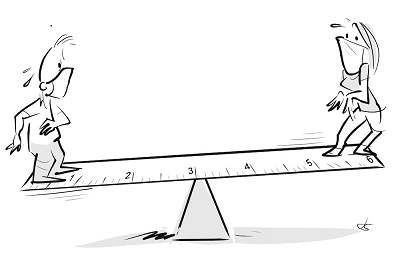
In the grocery store, you are told to stand back on the red line. You feel ashamed for not seeing it in the first place.
You tell your in-laws you are not comfortable having them visit their grandchildren in person, and you worry that they may never forgive you.
Someone asks you to stand farther away from them, and you feel embarrassed for making them feel uncomfortable.
You leave your house to go for a walk, wondering if you should wear a mask all the time, or just when you can’t maintain a safe distance. You feel anxious and unsure.
You reach out to pet a friendly dog, and when the owner asks you to please not touch their dog, you feel hurt.
You are wearing a mask while out on a walk, when a tickle in your nose brings on a loud sneeze. You look around guiltily to see if someone is angry for you possibly spreading germs in public.
Even if you didn’t have social anxiety before COVID, you probably have it now!
Social anxiety is defined as the fear of being judged, criticized or rejected by others. Those of us with social anxiety think that if we do things just right, we can avoid disappointing others and escape the dreaded possibility of being judged. Immunity from others’ judgments is always an unrealistic expectation, and now, with the rules changing, and a variety of opinions about what is safe, it is even more impossible.
Since we are bound to make mistakes following rules, and upset strangers, friends and family, this crisis is an opportunity to build some resilience to others’ judgments.
Three Essential Strategies to Decrease Social Anxiety
- Set a realistic intention when you venture out in public. It is impossible to follow rules that will please everyone, so instead, follow the rules that make the most sense to you based on recommendations from reputable sources. Expect and accept that others may not approve, adopting the expansive mindset -If I displease someone, I can forgive myself, whether they forgive me or not.
- Curb the urge to seek reassurance from others that you are doing the right thing. Getting reassurance reinforces the belief that if we do everything right, we will avoid criticism. True confidence comes from allowing for mistakes and accepting that we cannot please everyone.
- Allow any feelings of shame and embarrassment that arise to dissipate on their own. Negative emotions are not a sign that you have done something wrong. It is natural and inevitable that we will feel uncomfortable in uncertain social situations. When we open to uncomfortable emotions, rather than contract or try to distract ourselves from them, they will change more quickly.
To help yourself learn to welcome uncomfortable feelings that may arise from socially distancing situations where you feel anxious, download this imaginal meditation, Be All Right, Even When You’re Wrong.
There has never been a better time than now to practice self-compassion and tolerance for others’ judgments. Using these three strategies, we can gain confidence that empowers us to be more comfortable, more authentic in social settings. That’s confidence we’ll be grateful for long after this crisis passes!
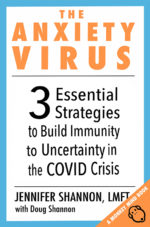
THE ANXIETY VIRUS: 3 Essential Strategies for Building Immunity to Uncertainty in the COVID Crisis
Now available both in Kindle and paperback format.
This article first appeared as an “Ask the Experts” article on the Anxiety and Depression Society of America website.
May 26, 2020 | Anxiety, Coronavirus
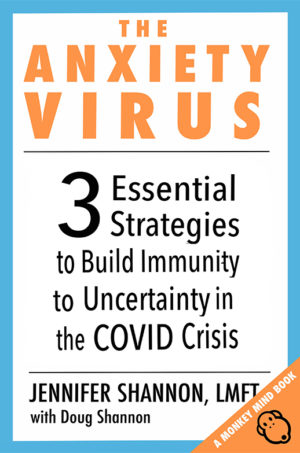
As the COVID crisis was revealing itself to us in late February, I was just finishing up a book on uncertainty. But over the past few months, we’ve become subject to a heightened level of uncertainty we’ve never known before that is creating much anxiety. That’s why I, with help from my husband Doug, have written a short new book with tools to cope with the unique uncertainties we are all facing NOW.
Health: Will I or my loved ones get sick and die? Are my elderly parents safe? Are these body sensations signs of Covid-19? Dare I go back to work?
Finances: Do I have enough money? Can I get government aid? Will my retirement fund recover? Can I pay my rent or mortgage? Will I lose my job? Will the company I work for reopen?
Supplies: Toilet paper, flour, rice, medications, meat—will there be enough?
Social: How much should I social distance? How much should I connect online? Will I lose my friends and connections?
General: How long will this last? Will my children fall behind academically? Do our elected officials know what they’re doing?
The Anxiety Virus addresses the uncertainties we face today, and every day for the foreseeable future. I believe this crisis is an opportunity. We can either contract, and try to white knuckle our way through this, or we can expand our capacity to accommodate everything that’s happening. This book gives strategies to help us not only survive this crisis, but to actually thrive.
COVID-19 has plunged us all into an atmosphere of extraordinary uncertainty, but with the right strategies, we can respond and adjust. Resilience to uncertainty is what we need right now. It will give us the flexibility and confidence we need to master any crisis!
This book comes with additional online audio meditations and downloadable worksheets!
Because of the urgent timeline, we decided to self-publish The Anxiety Virus on Amazon. It is now available both in Kindle and paperback format, and I invite you to order a copy. If you find it useful, I hope you’ll take the time to rate it, or if your so moved, leave a few words of review. Without a publisher, we’ll need some help to get the word out!
Since the “Look Inside” preview is not yet activated at Amazon.com, you can take a look inside and learn more here.
Endorsements…
“Jennifer Shannon has written a timely, readable and completely relevant guide to managing anxiety in these uncertain times. She has a knack for simple phrases that capture profound truths — such as “let fear metabolize” and “reasonable precaution enables reasonable risk”. Her conversational story-telling style universalizes these insights and guides the reader to a gentle practice of venturing out.”
Sally Winston, PsyD
Co-author of Needing to Know for Sure: A CBT-Based Guide to Overcoming Compulsive Checking and Reassurance-Seeking and Overcoming Unwanted Intrusive Thoughts,
“You can’t solve each new crisis that arises. But you can master the ability to tolerate uncertainty. The task is difficult, but it is simple. Spend some time with Jennifer Shannon’s book, and your body and mind will thank you for it.”
Reid Wilson, PhD
author of Stopping the Noise in Your Head
“Great suggestions for quieting inner turmoil, complete with specific examples of how we might cope with the challenges of media overload, fearing shortages of toilet paper, taking sniffles as a sign of death, and more. Great reading while you shelter in place!
Dave Carbonell, PhD,
“Coach” of the popular self-help site, anxietycoach.com, is the author of Panic Attacks Workbook, The Worry Trick, Fear of Flying Workbook, and Outsmart Your Anxious Brain: Ten Simple Ways to Beat the Worry Trick
May 8, 2020 | Anxiety, Coronavirus
On Monday May 4th, 2020 @ 2pm I participated in a discussion on the “About Health” radio program with Rona Renner, RN on radio station KPFA 94.1 FM in the San Francisco Bay Area. If you missed the live broadcast you can listen to the reply below.
We discussed ways to manage anxiety and build resilience.
With the Covid-19 Pandemic, anxiety about our health, safety, and future is high! It’s hard to relax when there is so much uncertainty. For many people it’s particularly challenging. Under normal conditions anxiety disorders affect 40 million adults in the US age 18 and older, and is thought to be the most common mental health problem in the US.
 A muffled crack of thunder, followed by a flash of light that lit up the bedroom wall. Then another, louder CRACK! I had been lying in bed awake since 1AM, for three hours, my husband next to me, deep asleep. But now the wind was pushing violently against our windows, and I woke him up. I did not want to be experiencing this alone. We pulled the slider open and stepped out onto our bedroom deck, surveying western Sonoma County. Every thirty seconds another jagged bolt of lightning flashed somewhere on the horizon. In forty years of living in California we’d ever seen anything like this. There were the thunderstorms when we visited my mother-in-law in Florida. But here we were missing a crucial counterbalance to the lightning. Rain.
A muffled crack of thunder, followed by a flash of light that lit up the bedroom wall. Then another, louder CRACK! I had been lying in bed awake since 1AM, for three hours, my husband next to me, deep asleep. But now the wind was pushing violently against our windows, and I woke him up. I did not want to be experiencing this alone. We pulled the slider open and stepped out onto our bedroom deck, surveying western Sonoma County. Every thirty seconds another jagged bolt of lightning flashed somewhere on the horizon. In forty years of living in California we’d ever seen anything like this. There were the thunderstorms when we visited my mother-in-law in Florida. But here we were missing a crucial counterbalance to the lightning. Rain.








Recent Comments